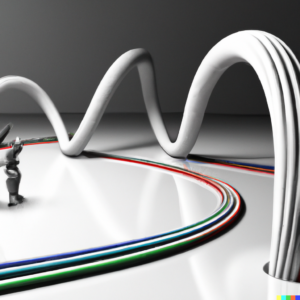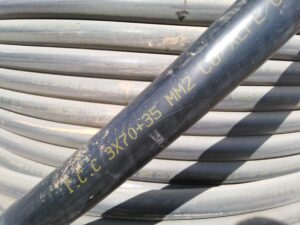Electric wires are a critical component of our modern infrastructure. They transport electricity from power plants and other sources to our homes, businesses, and appliances.
However, working with electric wires can be dangerous if not handled correctly. Bending an electric wire, regardless of whether it is energized or not, poses the risk of producing heat or creating a short circuit. This can result in the wire overheating and melting or, in severe cases, catching fire.
In this article, we will delve into the details of what happens when you bend an electric wire, both when it’s energized and when it’s not, and provide some best practices for working with electric wires.
Table of Contents
Bending a wire meaning
Bending a wire refers to the process of changing the shape or direction of a wire by applying force to it.
This is often done in order to fit the wire into a particular shape or to route it through a specific path.
Bending a wire can involve a variety of techniques, such as using pliers, bending tools, or forming the wire around a cylindrical object.
What Happens When You Bend an Energized Electric Wire?

When you bend an electric wire, whether it is energized or not, you run the risk of creating a short circuit or generating heat that can cause the wire to melt or even catch fire.
When a wire is energized and you bend it, the bending motion can cause the wire to touch other conductive materials, which can create a short circuit that can cause electrical shocks, fires, and other hazards.
When a wire is bent, it creates a smaller radius of curvature, which increases the resistance of the wire if there is more and more bending.
This can cause the wire to generate heat, which can lead to melting or even ignition if the wire is not designed to handle the heat.
The heating effect is more pronounced when the wire is carrying a high current, which is why wires that are part of critical equipment or that carry high voltage should not be bent unless it is absolutely necessary.
Therefore, it’s important to be aware of both the short circuit and heating hazards of bending electric wires and to take appropriate measures to prevent them.
This includes using proper tools and techniques when bending wires, avoiding sharp bends or kinks in the wire, inspecting the wire before and after bending it, and following safety protocols when working with electric wires.
Read also my comprehensive article: Cable Heating: The Silent Danger Lurking in Your Home
What Happens When You Bend an Electric Wire that is Not Energized?
In contrast, a wire that is not energized means that there is no electricity flowing through it. This is generally safer to handle than an energized wire, but it still has its risks.
When you bend a wire, it can weaken or break, especially if it’s old or corroded. This can cause it to fail when you try to use it later, leading to potential hazards.
For example, if you’re installing a new light fixture and bend the wire too sharply, it can create a weak spot that can break when you connect it to the fixture. This can cause the fixture to fall or malfunction, leading to injuries or damage to property.
That’s why inspecting wires before and after bending them is important to ensure they are still safe to use.
If you see any signs of damage, such as cracks, fraying, or kinks, it’s best to replace the wire rather than risk using it.
Read also my article on my safetyfrenzy site: Don’t Let Cable Overheating Put Your Home at Risk!
Does bending wires affect its resistance?
Yes, when an electric wire is bent, it can create a higher resistance in the wire due to a phenomenon called the “skin effect”.
The skin effect is a result of the way in which an alternating current (AC) flows through a conductor.
When an AC current flows through a wire, the current tends to flow primarily through the outer layer of the wire, rather than through the center. This is because the outer layer has less resistance than the center due to the way in which the magnetic field of the AC current interacts with the wire.
When a wire is bent, the radius of curvature of the wire is reduced, which causes the cross-sectional area of the wire to decrease. This, in turn, increases the resistance of the wire because there is less space for the current to flow through.
Additionally, the bending of the wire can disrupt the uniform flow of the current, causing it to concentrate on certain areas of the wire, further increasing the resistance.
The increased resistance can cause the wire to heat up and potentially melt or catch fire, particularly if the wire is carrying a high current.
Therefore, it’s important to be aware of the potential resistance effects of bending wires and to use proper techniques and safety protocols to avoid potential hazards.
Best Practices for Bending Electric Wires
Now that we’ve discussed the risks of bending electric wires, let’s discuss some best practices for safely doing it.
First and foremost, always assume that a wire is energized until you can confirm that it’s not. This means turning off the power to the circuit or using a voltage tester to check for electricity before handling the wire.
Even if you’re sure that the wire is not energized, it’s still a good idea to wear rubber gloves and other protective gear to avoid injuries from sharp edges or other hazards.
When bending a wire, use the proper tools, such as pliers or wire strippers, to avoid damaging it. Avoid using your hands or teeth to bend the wire, as this can cause the wire to kink or break.
Additionally, make sure to bend the wire gently and avoid sharp bends that can weaken the wire.
If you’re working with a wire that has already been bent or has signs of damage, it’s best to replace it rather than try to use it.
This is especially important for wires that will be carrying a high voltage or that are part of critical equipment.
Finally, always follow safety protocols when working with electric wires. This means using proper insulation, grounding, and other safety measures to prevent electrical shocks and other hazards.
If you’re not sure how to handle a specific type of wire or equipment, it’s best to consult a professional electrician.
Conclusion
In conclusion, bending an electric wire can be dangerous if not done correctly. When a wire is energized, bending it can create a short circuit that can cause electrical shocks, fires, and other hazards.
When a wire is not energized, bending it can weaken or break the wire, leading to potential hazards later on.
To avoid these risks, always assume that a wire is energized until you can confirm that it’s not, use proper tools and techniques when bending wires, inspect wires before and after bending them, and follow safety protocols when working with electric wires.
By following these best practices, you can safely work with electric wires and avoid the dangers of electrical hazards.
Install my Free Android App on Google Play:
Electrical Cables Most Common Tables
And, my Electrical Calculations App “”
Discover more great content by subscribing to My channel
Looking to stay ahead of the game in the world of electrical engineering? Subscribe to my YouTube channel and gain access to exclusive content you won’t find anywhere else!
The staff I recommend
(Amazon Affiliate Links to products I believe are high quality):
- Economy 120 Volt/60Hz AC Power Source – Step-Down Voltage & Frequency Converters 1800W
- UNI-T Digital Multimeter Tester UT139C
- 50-Amp Extension Cord for RV “100ft”
- Voltage Stabilizer 110/220v
- Hair Dryer “best selling“
- TOSHIBA EM131A5C-BS Countertop Microwave Ovens
Disclaimer: This contains affiliate links to Amazon products. I may earn a commission for purchases made through these links.



